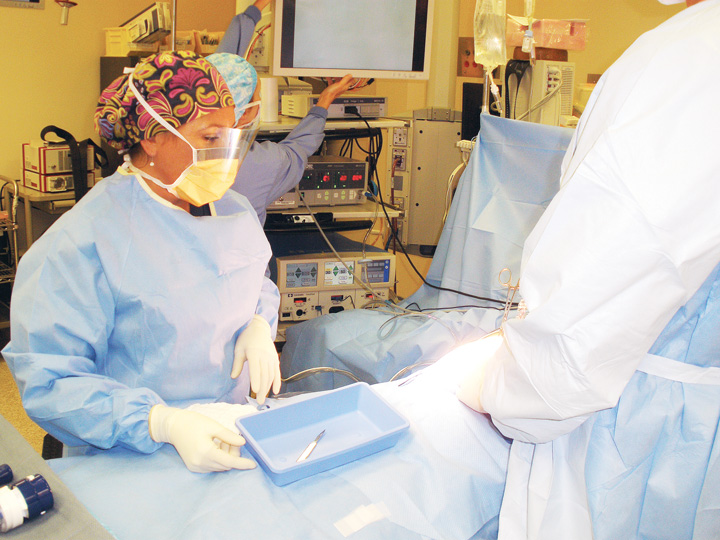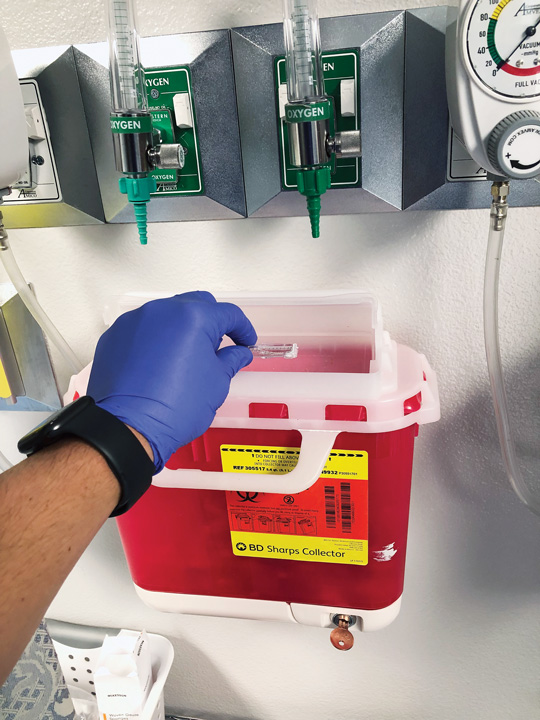- Home
- Article
The Essentials: The Sticking Points of Sharps Safety
By: Joe Paone | Senior Editor
Published: 11/20/2023
A combination of policy, safety-engineered devices, effective strategies, and consistent communication and education can reduce injury risks.
No matter how prepared your center, surgeons and staff are about sharps injuries, these potentially devastating incidents still can (and probably will) occur. Preventing them is all about staying on top of this existential issue on multiple fronts to ensure that complacency and corner-cutting don’t set in among your team.
Elements of success
Successful sharps safety programs require a standardized combination of continual education, mindfulness, safety-engineered instruments, strategic adjustments, emergency preparedness and the development of an internalized, collaborative vigilance and awareness of the dangers of sharps.
The stakes are high, as percutaneous sharps injuries can create bloodborne pathogen exposures — most commonly to hepatitis C, hepatitis B and HIV, though patients could transmit other dangerous bacteria and organisms like S. aureus — that can lead to calamitous and even lifelong infections for the victim.
We spoke with two members of the Association for Professionals in Infection Control and Epidemiology’s (APIC’s) Communication Committee — Katelyn Harms, MPH, CIC, infection prevention program manager for the performance improvement department at UnityPoint Health-Meriter Hospital in Madison, Wis., and Benjamin D. Galvan, MLS(ASCP), CIC, CPH, director of infection prevention at HCA Florida South Tampa Hospital — to get a better sense of what an effective surgical sharps safety program looks like.
Components of sharps safety

There’s no foolproof, absolute solution to sharps safety. Rather, it’s a checklist of considerations that in combination keep your providers much safer, but must constantly be monitored, refreshed and reinforced.
• Evaluate what you can remove or replace. “Look at what’s called the hierarchy of controls to decide the best ways to help prevent injuries,” says Mr. Galvan. “At the top is removing something altogether. If you can remove the potential for the injury, then you are protecting your workers. Ultimately, removing risk is the best thing, though obviously that’s not always an option, so go further down the hierarchy of controls. Can you substitute one item for another that is safer, or something newer that was developed with safety in mind? Work your way down to the last one, which is personal protective equipment.”
Embedded in that hierarchy are engineering controls. “Certain devices are now manufactured in a way that helps prevent activities that are considered higher risk for percutaneous injury compared to others,” says Mr. Galvan. For example, instead of needing to manually cap a needle, some new products enable a one-handed flick of the thumb to cap it, he says.
• Employ safe passing technique. “Have a neutral hands-free zone for passing sharps,” says Ms. Harms. “Everyone should know where the zone is designated and how to use it.” She says surgeons and staff should speak of the zone during procedures and ensure sharps are always secured. For example, providers should avoid passing sutures back and forth with a needle dangling.
“Instead of handing sharps directly to someone else, have a sterile way of passing the sharps from one person to the next that doesn’t involve directly handling it,” adds Mr. Galvan.
• Manage sharps intraoperatively. “Organize your workspace well so you know where all your sharps are at any given time. Never let one leave your field of vision,” says Mr. Galvan, adding that sharps should never go missing during a surgery and that workspaces should always be well-lit.
• Properly use safety-engineered sharps where appropriate. Surgeons and OR staff might be skeptical about the effectiveness of safety-engineered sharps devices like safety scalpels and blunt-tip suture needles, but the products are constantly improving. The key for OR providers, says Ms. Harms, is to use these devices properly while recognizing that safety-engineered sharps do not inherently guarantee safety. “Engineering controls can be a helpful tool in preventing exposures, but they are not the end-all/be-all for safety,” she says. “They’re not 100% reliable, and they rely on people knowing how to use them appropriately. We’ve always let our staff know to not let their guard down when using these devices. Be mindful of their safety mechanisms, because before you engage it, it’s still sharp.”
• Double-glove. Wearing two sets of different-colored gloves may not always prevent a sharps injury, but it can raise awareness in the moment that one may have occurred. “It’s certainly helpful when you have a nick in that top glove because it gives you that visual cue that you need to either change your gloves or investigate if something happened,” says Ms. Harms. “From an infection prevention point of view, that additional barrier protection is helpful.”
• Properly dispose of sharps. This should be done as soon as possible after use. Mr. Galvan recommends regularly scheduled audits of this process. “Part of your sharps safety program should be evaluating waste management to see if there is an opportunity to reeducate your team on proper disposal,” he says. “A leading cause of sharps injuries is overfilled sharps containers. Staff shouldn’t be reaching back into those containers if something was accidentally disposed of.” One way to prevent issues here, says Mr. Galvan, is designating someone to stay on top of removing full containers.
• Keep sterile processing department (SPD) pros in mind. “One trend I’m appreciating is the higher level of attention being paid to sharps injuries for our SPD folks, who deserve equal safety,” says Ms. Harms. She notes that conscientious facilities are focusing on improving workflow around handling instruments postoperatively, in part to better protect reprocessing techs from injuries. “There’s been a significant amount of work on how we prepare instruments after a case, how they are placed in the tray, picking out the sharps and making sure they are placed in a designated space that’s visible and known,” she says.
The goal is to not deliver a large jumble of instrumentation to SPD that techs simply dump into a sink. “Techs reach their hands into that soapy space with not always perfect visibility,” says Ms. Harms, noting that sharps injuries can occur as a result. In addition to SPD techs wearing appropriate PPE including extremely durable gloves, she says OR staff should place any sharps on an appropriate mat or designated space in the tray after each case.
• Develop an injury response plan. When an injury occurs, what needs to happen? “Number one is communication. The one thing you don’t want to do is not say anything,” says Mr. Galvan. “If your surgeon is injured, you don’t want them to bleed into the patient as well. Report it immediately, whether that’s directly to your supervisor, contacting employee health or going to an emergency department. Each facility needs to have a post-exposure process in place.”
Mr. Galvan says the affected employee should exit the OR or SPD immediately because their sterility has been breached. The injury should then immediately be flushed and cleaned for a defined amount of time. The incident should also trigger any required testing for both the injured employee and the source patient, both immediately and possibly down the road.
Communication and mindfulness are key

Ultimately, tactical strategies like double-gloving, neutral passing zones and using safety-engineered sharps will not, on their own, prevent sharps injuries. The most important aspect of sharps safety, experts say, is effective communication and constant mindfulness. OR teams should never become complacent or develop a false sense of security about sharps safety — no matter how comprehensive their injury prevention program is.
How can you help your surgical staff maintain a constant level of mindfulness? According to Ms. Harms, regular refresher education is a big part. “Going back to basics is always helpful and really the best place to start. Even if you have seasoned staff, technique can wane over time,” she says. Because OSHA standards require annual education about sharps safety exposure, you have a built-in reason to revisit the topic. “Take that time to make it meaningful for your staff,” says Ms. Harms.
Continuing education and refreshers can only go so far, however. “Another important strategy is situational awareness,” says Ms. Harms. “I think people have a generally good situational awareness of sharps risk for themselves, but they also need to be aware of those around them. That extends beyond the immediate handling of a device during a case to the before and after moments as well — when the sharps device is being unpackaged, when it’s being disposed of and when it’s being passed down to SPD.”
Adds Mr. Galvan, “Typically, these types of injuries happen because we’re moving too fast and not maintaining awareness of our task at hand, where the sharp is going and what it is being used for. Is there a culture of safety in your OR environment, or is it a culture where you want to get things done as quickly as possible and kind of letting safety go by the wayside?”
Mr. Galvan stresses the use of contextual verbal communication. “Make sure staff are communicating when they have sharps or when they’re handing something off into the field,” he says.
Ms. Harms says providers who have suffered sharps injuries in the past can serve as great resources for your program and their teams. “When I’ve discussed sharps safety with providers, the people who are always the most engaged with that conversation are the people who have already had a needlestick event in their practice,” she says. “If it’s happened to them before, they are exceptionally mindful, aware and usually happy to share their story. Use those cautionary tales to educate the next generation.”
Effective leadership
“From a leadership standpoint, a culture of safety needs to be driven from the top down,” says Mr. Galvan. “If individuals at the top are pressuring people to move as fast as possible, and not maintaining a level of safety and awareness in that messaging, it can cause providers to lose focus on their own safety, and you’ll likely see opportunities for injuries.” Strong leadership, he says, really has to do with communication, where team members feel safe to bring up opportunities for improvement in their spaces.
“Bring awareness to near misses, and make sure that 100% of your actual events are communicated with your frontline so they know these things are happening,” adds Mr. Galvan. “Dig deep into those events to understand the ‘why’ behind them. Was it an issue with the device? If so, what can you do to either substitute or remove that device entirely? Was it a lack of education or understanding of how the device worked? Is it something you haven’t really thought of that could cause a sharps injury and now it has in this particular instance?” Ultimately, there are many things you can do to bring awareness to sharps safety, and keep it at the forefront of your staff’s minds each day. The key is to commit to an honest, inclusive and pragmatic culture of safety where teams communicate and work in harmony to avoid sharps injuries — and can respond effectively on those rare but unfortunate occasions when sharps injuries inevitably occur despite their collective best efforts. OSM
.svg?sfvrsn=be606e78_3)
.svg?sfvrsn=56b2f850_5)